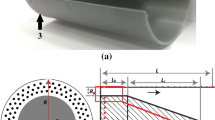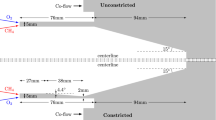Abstract
Rotating detonation engines (RDEs) have been observed to exhibit several operating modes and instabilities under different operation conditions (reactant mixture, injection pressure, engine geometry, injection mass flow rate, etc.). We develop the simplest model possible describing the operation of an RDE. This model takes into account the dependence of detonation properties on engine conditions, the injection process, and the geometric constraints. Using this model, we predict the lowest allowable reactant injection rates that allow an RDE to operate with a single detonation wave propagating in the annular combustion chamber. This model is compared with experimental results of engines running on H\({}_2\)/O\({}_2\) and C\({}_2\)H\({}_4\)/O\({}_2\).










Similar content being viewed by others
Abbreviations
- \(C_{L}\) :
-
Cell size scaling constant for \(L_\mathrm {cr}\)
- D :
-
Nominal engine diameter
- F :
-
Thrust
- h :
-
Combustion chamber annulus thickness
- \(I_\mathrm {sp}\) :
-
Specific impulse
- \(K_{L}\) :
-
Annulus thickness scaling constant for \(L_\mathrm {cr}\)
- \(L_\mathrm {cr}\) :
-
Length of detonating zone in the combustion chamber
- \(\dot{m}\) :
-
Mass flow rate through the engine
- P :
-
Pressure
- \(R_\mathrm{sp}\) :
-
Specific gas constant
- T :
-
Temperature
- \(U_\mathrm {CJ}\) :
-
Chapman–Jouguet detonation wave speed
- \(U_\mathrm {D}\) :
-
Detonation wave speed
- \(V_\mathrm {inj}\) :
-
Reactant injection velocity
- \(\theta \) :
-
Angle of reactant injection surface
- \(\lambda \) :
-
Detonation cell width
- \(\rho \) :
-
Density
- \(\phi \) :
-
Equivalence ratio
- \(\omega \) :
-
Wavenumber: number of co-rotating detonation waves within the combustion chamber
- \(*\) :
-
Choking property
- \(\mathrm {0}\) :
-
Stagnation property
- \(\mathrm {ref}\) :
-
Reference state
References
Nicholls, J., Cullen, R.: The feasibility of a rotating detonation wave rocket motor. Technical Documentary Report RPL-TDR-64-113, Michigan University, Ann Arbor, Michigan (1964)
Adamson Jr., T.C., Olsson, G.: Performance analysis of a rotating detonation wave rocket engine. Astronaut. Acta 13(4/5), 405–415 (1967)
Shen, I.W., Adamson, T.C., Jr.: Theoretical analysis of rotating two phase detonation in a rocket motor. Michigan University, Technical Report (1973)
Bykovskii, F.A., Zhdan, S.A., Vedernikov, E.F.: Continuous spin detonations. J. Propul. Power 22(6), 1204–1216 (2006). https://doi.org/10.2514/1.17656
Zhdan, S.A., Bykovskii, F.A., Vedernikov, E.F.: Mathematical modeling of a rotating detonation wave in a hydrogen–oxygen mixture. Combust. Explos. Shock Waves 43(4), 449–459 (2007)
Wolanski, P.: Rotating detonation wave stability. 23rd International Colloquium on the Dynamics of Explosions and Reactive Systems, UC Irvine, CA, USA, Paper 211 (2011)
Kindracki, J., Wolanski, P., Gut, Z.: Experimental research on the rotating detonation in gaseous fuels–oxygen mixtures. Shock Waves 21(2), 75–84 (2011). https://doi.org/10.1007/s00193-011-0298-y
Wolanski, P.: Detonative propulsion. Proc. Combust. Inst. 34(1), 125–158 (2013). https://doi.org/10.1016/j.proci.2012.10.005
Yamada, T., Hayashi, A.K., Yamada, E., Tsuboi, N., Tangirala, V.E., Fujiwara, T.: Detonation limit thresholds in H\(_{2}\)/O\(_{2}\) rotating detonation engine. Combust. Sci. Technol. 182(11–12), 1901–1914 (2010). https://doi.org/10.1080/00102202.2010.498676
Tsuboi, N., Watanabe, Y., Kojima, T., Hayashi, A.K.: Numerical estimation of the thrust performance on a rotating detonation engine for a hydrogen–oxygen mixture. Proc. Combust. Inst. 35(2), 2005–2013 (2015). https://doi.org/10.1016/j.proci.2014.09.010
Bennewitz, J.W., Bigler, B.R., Hargus, W.A., Danczyk, S.A., Smith, R.D.: Characterization of detonation wave propagation in a rotating detonation rocket engine using direct high-speed imaging. 2018 Joint Propulsion Conference, Cincinnati, OH, AIAA Paper 2018–4688 (2018). https://doi.org/10.2514/6.2018-4688
Anand, V., St. George, A., Driscoll, R., Gutmark, E.: Characterization of instabilities in a rotating detonation combustor. Int. J. Hydrogen Energy 40(46), 16649–16659 (2015). https://doi.org/10.1016/j.ijhydene.2015.09.046
Russo, R.M.: Operational characteristics of a rotating detonation engine using hydrogen and air.Master’s Thesis, Air. Force Institute of Technology, Wright-Patterson Air Force Base, Ohio (2011)
Lu, F.K., Braun, E.M.: Rotating detonation wave propulsion: experimental challenges, modeling, and engine concepts. J. Propul. Power 30(5), 1125–1142 (2014). https://doi.org/10.2514/1.B34802
Anand, V., St. George, A., Driscoll, R., Gutmark, E.: Longitudinal pulsed detonation instability in a rotating detonation combustor. Exp. Therm. Fluid Sci. 77, 212–225 (2016). https://doi.org/10.1016/j.expthermflusci.2016.04.025
Bohon, M., Bluemner, R., Paschereit, C., Gutmark, E.: High-speed imaging of wave modes in an RDC. Exp. Therm. Fluid Sci. 102, 28–37 (2019). https://doi.org/10.1016/j.expthermflusci.2018.10.031
Shepherd, J.E., Kasahara, J.: Analytical models for the thrust of a rotating detonation engine. Technical Report FM2017.001, Graduate Aerospace Laboratories, California Institute of Technology, Pasadena, California (2017)
Fievisohn, R.T., Yu, K.H.: Steady-state analysis of rotating detonation engine flowfields with the method of characteristics. J. Propul. Power 33(1), 89–99 (2017). https://doi.org/10.2514/1.B36103
Sousa, J., Paniagua, G., Collado Morata, E.: Thermodynamic analysis of a gas turbine engine with a rotating detonation combustor. Appl. Energy 195, 247–256 (2017). https://doi.org/10.1016/j.apenergy.2017.03.045
Kaemming, T., Fotia, M.L., Hoke, J., Schauer, F.: Thermodynamic modeling of a rotating detonation engine through a reduced-order approach. J. Propul. Power 33(5), 1170–1178 (2017). https://doi.org/10.2514/1.B36237
Koch, J., Kurosaka, M., Knowlen, C., Kutz, J.N.: Mode-locked rotating detonation waves: experiments and a model equation. Phys. Rev. E 101, 013106 (2020). https://doi.org/10.1103/PhysRevE.101.013106
Kudo, Y., Nagura, Y., Kasahara, J., Sasamoto, Y., Matsuo, A.: Oblique detonation waves stabilized in rectangular-cross-section bent tubes. Proc. Combust. Inst. 33(2), 2319–2326 (2011). https://doi.org/10.1016/j.proci.2010.08.008
Jackson, S., Short, M.: The scaling of the diameter-and thickness-effect curves for ideal, insensitive, and non-ideal explosives. 24th International Colloquium on the Dynamics of Explosions and Reactive Systems, Taipei, Taiwan, Paper 226 (2013)
Short, M., Jackson, S.I.: Dynamics of high sound-speed metal confiners driven by non-ideal high-explosive detonation. Combust. Flame 162(5), 1857–1867 (2015). https://doi.org/10.1016/j.combustflame.2014.12.007
Maxime, R., Florent, V., Ashwin, C., Cedex, F.C.: Interactions of a detonation wave conned by a high-temperature compressible layer. 26th International Colloquium on the Dynamics of Explosions and Reactive Systems, Boston, MA, Paper 970 (2017)
Mi, X.C., Higgins, A.J., Kiyanda, C.B., Ng, H.D., Nikiforakis, N.: Effect of spatial inhomogeneities on detonation propagation with yielding confinement. Shock Waves 28(5), 993–1009 (2018). https://doi.org/10.1007/s00193-018-0847-8
Chiquete, C., Short, M., Quirk, J.J.: The effect of curvature and confinement on gas-phase detonation cellular stability. Proc. Combust. Inst. 37(3), 3565–3573 (2019). https://doi.org/10.1016/j.proci.2018.09.005
John, J., Keith, T.: Gas Dynamics. Pearson Prentice Hall, Upper Saddle River (2006)
Gordon, S., McBride, B.: Computer program for calculation of complex chemical equilibrium compositions and applications. I. Analysis. NASA RP-1311, National Aeronautics and Space Administration, Washington, DC (1994)
Kaneshige, M., Shepherd, J.E.: Detonation database. Explosion Dynamics Laboratory Report FM97-8, California Institute of Technology, Pasadena, California (1999)
Hansmetzger, S.: Etude des modes de rotation continue d’une détonation dans une chambre annulaire de section constante ou croissante. PhD Thesis, ENSMA (2018)
Acknowledgements
This work would not have been possible without the numerous discussions which took place with A.J. Higgins of McGill University and X. Mi currently at McGill University. This work was supported by a Discovery Grant from the National Science and Engineering Research Council of Canada.
Author information
Authors and Affiliations
Corresponding author
Additional information
Communicated by E. Gutmark.
Publisher's Note
Springer Nature remains neutral with regard to jurisdictional claims in published maps and institutional affiliations.
Rights and permissions
About this article
Cite this article
Connolly-Boutin, S., Joseph, V., Ng, H.D. et al. Small-size rotating detonation engine: scaling and minimum mass flow rate. Shock Waves 31, 665–674 (2021). https://doi.org/10.1007/s00193-021-00991-2
Received:
Revised:
Accepted:
Published:
Issue Date:
DOI: https://doi.org/10.1007/s00193-021-00991-2




